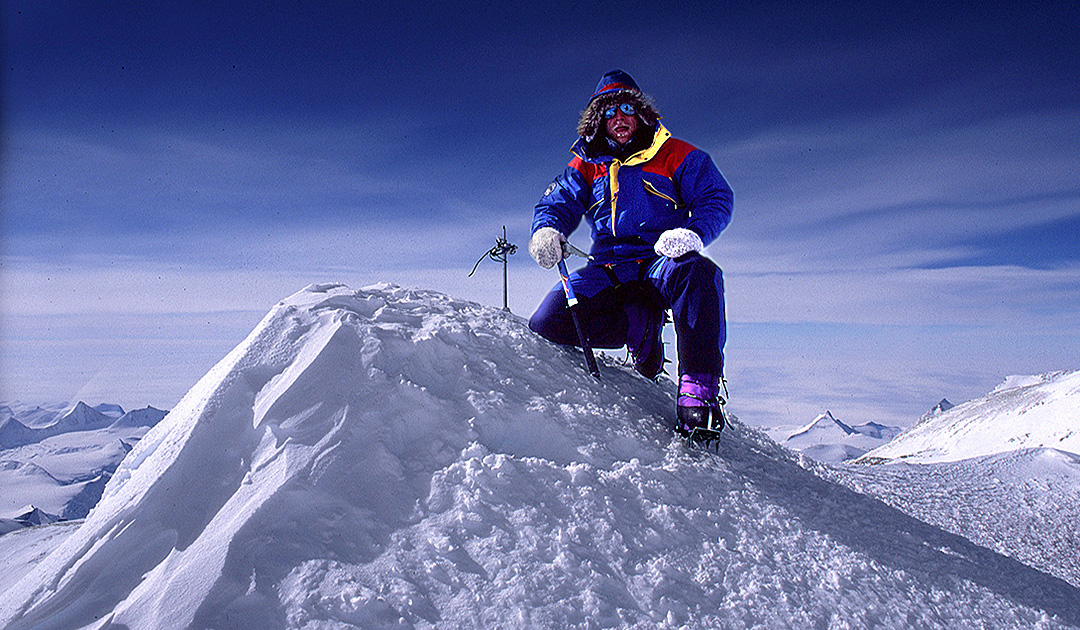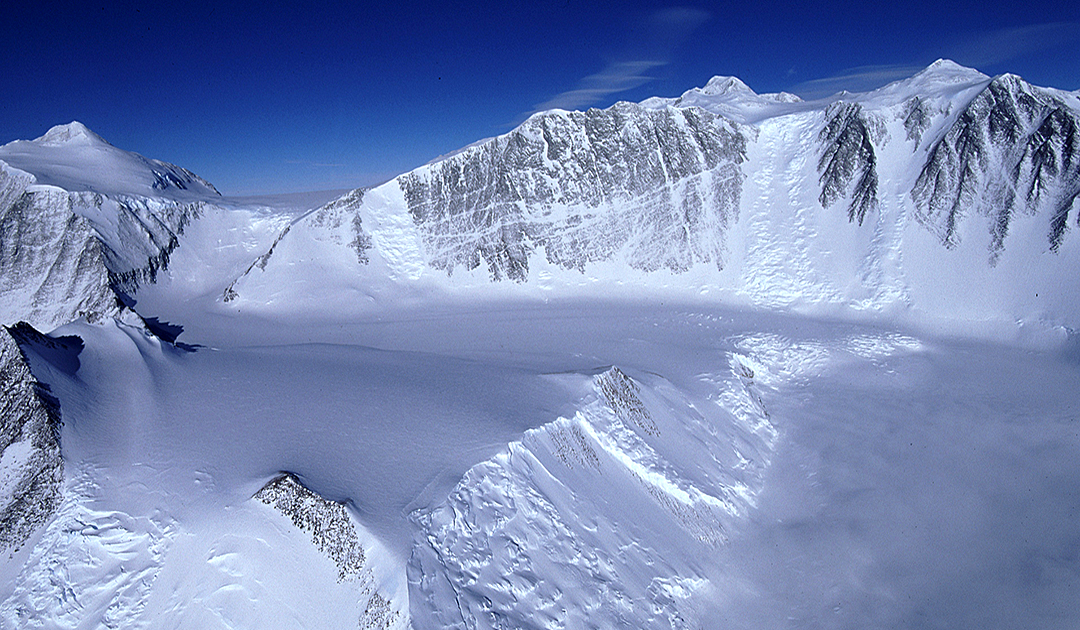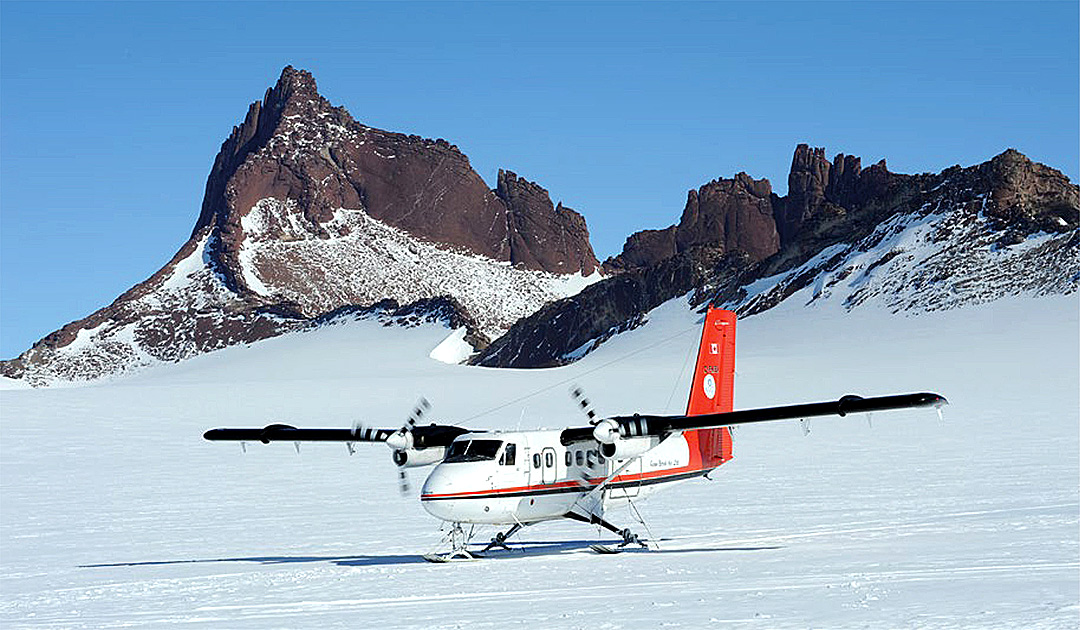
The beginnings of mountaineering in Antarctica
The first mountain tour on the white continent was undertaken in the course of the British Southern Cross expedition by the physicist Louis Bernacchi and the expedition leader Carsten Borchgrevink at Cape Adare in Victoria Land in April 1899. The Gauss expedition, the first German Antarctic expedition led by Erich von Drygalski, then climbed Gaussberg (365 m) in Kaiser Wilhelm II’s Land in March 1902. And on March 10, 1908, the first major mountain in Antarctica was successfully climbed: in an adventurous five-day tour, members of the Nimrod Expedition led by Ernest Shackleton reached the summit of Mt. Erebus (3795 m) on Ross Island. The second ascent was made on December 13, 1912, by the Terra Nova expedition led by Robert F. Scott (who had perished nine months earlier while returning from the South Pole with his team). From the beginning of the 20th century, numerous relatively easily accessible mountains on the Antarctic Peninsula were climbed. As the continent was then opened up with research stations in the following decades, the mountains surrounding and in the hinterland of the stations were also climbed, such as in the Transantarctic Mountains near the US base McMurdo and the New Zealand Scott Station.
Mountaineering in Antarctica at that time was reserved for participants in national research programs as part of their scientific (and pseudoscientific) tasks, for example to take samples or install measuring equipment. In the 1950s and 1960s, during the legendary dog sled traverses, numerous mountains were climbed, mostly the highest and easiest to reach peaks, primarily to get an overview of the terrain to be explored. Mountaineering was a means to the end of conducting geographical and natural science research. In the 1970s and 1980s, quite a few peaks were reached simply by helicopter. Mountaineering for its own sake was sometimes welcomed or at least tolerated, depending on the national research program, but was mostly frowned upon or prohibited. Many an adventurous explorer nevertheless climbed the mountain in his spare time. Often quietly and without publishing about it. This was only to change with the help of some visionary mountaineers and polar pioneers in the mid-1980s.

Mt. Vinson – the highest mountain in Antarctica
Only after the struggle for the first ascents of all eight-thousanders had long since ended and only two and a half years before the first moon landing, did an elaborate expedition of the American Alpine Club, led by Nicholas Clinch and with financial help from the National Geographic Society as well as logistical support from the U.S. Navy, succeed in reaching the highest point of Antarctica for the first time. On December 18, 1966, Barry Corbet, John Evans, William Long and Pete Schoening, who had already succeeded in the first ascent of Gasherbrum (Hidden Peak) in the Karakorum in 1958, became the first people to stand on the summit of Mt. Vinson. At that time it was measured with a height of 5140 meters – clearly too high, as it should turn out later. It was one of the few official U.S. expeditions with primarily alpine intentions, and a particularly successful one at that. In fact, she immediately succeeded in the first ascents of Mt. Shinn (4660 m) and the difficult Mt. Gardner (4573 m) and Mt. Tyree (4852 m). The extremely demanding Mt. Epperly (4508 m) was only climbed on December 1, 1994 by Erhard Loretan, solo, over a steep ice couloir through its 2100 meter high south face.
The second and not entirely uncontroversial ascent of Mt. Vinson was achieved on December 22, 1979, by the Germans Peter von Gizycki and Werner Buggisch and the Russian Vladimir Samsonov during a U.S. research expedition. However, because the three mountaineering geologists had neither the official mandate nor authorization to climb, their action led to a disagreement with the U.S. Antarctic Research Program (USARP). Tourism in Antarctica and thus mountaineering and skiing for purely hedonistic reasons were against its policy. But a scientific pretext was found: With a highly visible red flag improvisedly planted on a ski pole on the summit, the height of the Vinson massif could be trigonometrically remeasured for the Geological Survey and corrected to 4897 meters. The ski pole remained and adorned the summit until 2007.
From the mid-1980s, Mt. Vinson then became the target of desire as one of the so-called Seven Summits, the highest mountains on all seven continents. American millionaires Dick Bass, owner of Snowbird Ski Resort in Utah, and Frank Wells, president of Warner Brothers Studios and later the Walt Disney Company, paid top alpinists to guide them to the coveted peaks. For Mt. Vinson, they hired mountaineering legends Chris Bonington and Rick Ridgeway. But neither the American National Science Foundation nor the British Antarctic Survey wanted to support this private venture. It was only through a diplomatic and aeronautical masterstroke by polar pilot Giles Kershaw that they finally succeeded in making the third ascent of the mountain on November 23, 1983. Reinhold Messner also wanted to participate. He was booted out, however, because otherwise he would have snatched away the glory of being the first man (and “real” alpinist) on the Seven Summits from the Americans. Bass and Wells sparked a global mountain travel boom with their book Seven Summits. In the wake of this, Messner was then able to climb Mt. Vinson and thus, six months after Pat Morrow and as the second person ever, complete the more demanding Seven Summits list – with the Carstensz Pyramid as the highest mountain in Australoceania.

Reaching Mt. Vinson was much more difficult to achieve than the actual climb. The pioneering work and courage of Giles Kershaw and the innovative spirit of the British glaciologist Charles Swithinbank made it possible to fly directly into the interior of Antarctica not only with small ski planes but also with larger transport planes. Key to the development of civil polar aviation and thus private expeditionary operations in Antarctica was the discovery of a field of blue ice swept bare by katabatic winds at the base of the Patriot Hills in the Heritage Range. Here, Polar aviation pioneer Kershaw was able to land and take off a wheeled aircraft, a DHC-6, for the first time in the continent’s interior on December 01, 1986. He and Canadian alpinists Pat Morrow and Martyn Williams, who had made the fourth ascent and also the first ski descent of Mt. Vinson, recognized the potential of making Antarctica’s highest mountains accessible to Seven Summit aspirants. They founded the ANI logistics network, which was the first private airline to transport well-heeled mountaineers from Punta Arenas in Chile to Mt. Vinson and enabled private ski expeditions to the South Pole: an innovation that abruptly changed the accessibility of Inner Antarctica for private expeditions. It then also made possible the 2390-kilometer Antarctic transversal by Reinhold Messner and Arved Fuchs in 1989/90, as well as the spectacular 6048-kilometer international dog sled expedition Trans-Antarctica.
The idea of climbing the highest mountain on each continent spurred a worldwide alpine travel industry. Mt. Vinson attracted climbers from all over the world, it was successfully skied or flown not only by alpine and telemark skiers (Pat Morrow and Martyn Williams, 1985) but also paragliders (Vernon Tejas, 1988) and snowboarders (Stephen Koch, 1999).

I had the privilege in the early 2000s of managing the small polar base Mt. Vinson Base Camp of ANI and to climb the mountain a total of five times. Those were still wild pioneer times with a lot of freedom in the highest mountains of Antarctica. The Antarctic silence and remoteness gave me some of the most intense experiences of my life. At that time, Damien Gildea also came to the camp, traveling repeatedly to the Sentinel Range to climb the highest mountains and digitally survey them using the latest GPS technology. Today, we owe the Australian alpine pioneer not only the most accurate and officially valid altitude of Mt. Vinson – 4892 meters – but also the most detailed chronicle of Antarctic alpine history.
Since then, a lot has happened on the mountain. The adventurous times when you were left to your own devices as a base camp manager in this massive massif are over. Back then there were only a few dozen climbers each year, but now there are between 150 and 200 climbers there every year during the short summer season from November to the end of January. Since Antarctic Logistics & Expeditions took over the pioneering organization, Vinson Basecamp has been professionally expanded and staffed by several people. On the mountain itself, since 2007, the route is no longer via the risky flank to the Vinson-Shinn saddle, which is threatened by icefall and riddled with crevasses, but via fixed ropes over a somewhat steeper but safe ice slope along the Vinson west face. There are predetermined high camp sites and even patrolling rangers. And the legendary Patriot Hills main base, with its notorious katabatic downdrafts blowing across the landing direction, was also replaced in 2010 with a new camp and upwind airstrip on Union Glacier.
Mt. Vinson has become the most frequently climbed mountain on the continent, except for the 230-meter-high Observation Hill near the settlement-like U.S. polar station McMurdo. All this, however, has not taken away any of the mountain’s fascination. The good fortune of standing on this exclusive peak and the roof of Antarctica, enjoying the views over the Ellsworth Mountains and the vastness of the Ice Sheet, continues to make every climber’s heart rejoice.

Mountaineering and environmental protection in Antarctica
Antarctica is not only the southernmost, coldest, windiest and driest, but also the most peaceful and the cleanest continent on earth. Glaciation, climatic conditions and the (still) too high costs protect it so far from geological resource exploitation.
Reaching Antarctica raises no more or less questions aboutCO2 emissions than modern air or sea travel to other continents. But already on arrival there is a difference: the equipment must be scrupulously cleaned with vacuum cleaners and the shoes must be disinfected before entering Antarctica. No germs or seeds should be introduced. An environmentally conscious approach appears to be nothing more than an empty phrase on many of the world’s mountains, if one thinks, for example, of the garbage dumps in base camps or the routes and high camps of the overrun “world mountains” littered with fecal matter. In Antarctica, on the other hand, environmental protection is an everyday practice. Thus, from the Antarctic mountains, all waste, including feces, is taken back from the mountain, carried to base camp, and flown out. Due to the low temperatures, microbiological decay processes are extremely slow, which would preserve any organic material for centuries. For example, Peter von Gizycki reported finding an apricot from the first climbers at the summit of Mt. Vinson that was still unspoiled after 13 years and tasted excellent.

The 1991 Environmental Protocol to the Antarctic Treaty no longer allows alien species on the continent. The fact that environmental rules also ban the elegant dog sled teams to protect native wildlife from communicable diseases is sad, but understandable. Motor vehicles of all types, on the other hand, are permitted. Now mountaineers have to rely on ski planes or vehicles or, in a very modern and environmentally friendly way, ski and wind sail in the white wilderness. In Antarctica, there is also no indigenous population that could help with transport – and on the other hand would be exposed to a culture conflict by expedition climbers.
Author: Christoph Höbenreich
More about the series:






I summited Vinson on January 3rd 2022 and to prepare myself I read lots of books and expedition journals. Still, I enjoyed this short but very nice read. Thanks.